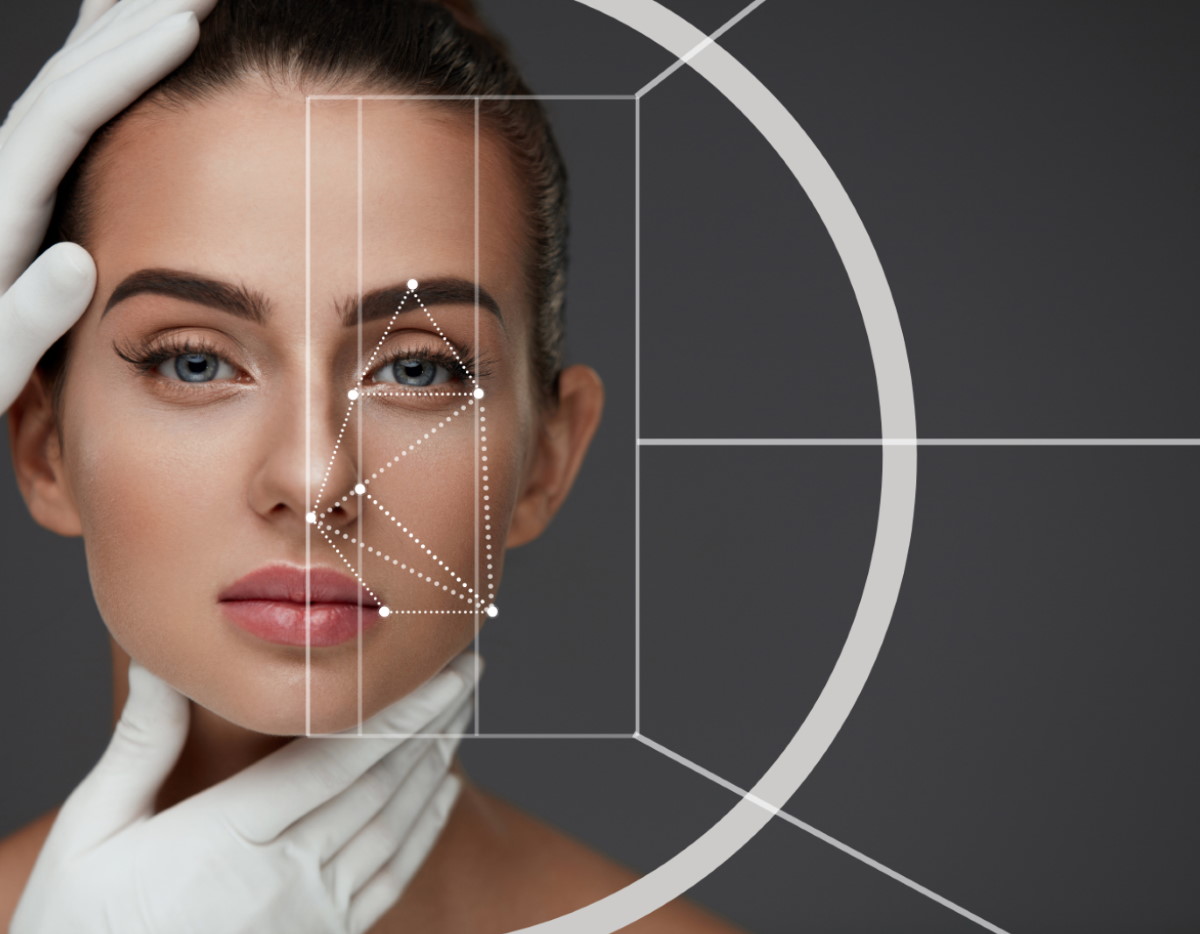For centuries people have been trying to figure out what it is that makes someone more beautiful than others. There is no simple answer to this question. We often hear the phrase, “beauty is in the eye of the beholder”. However, is it possible that there are certain features that are recognized as beautiful universally around the world? Kalology is the study of facial beauty and the way in which our beauty affects our lifestyle and role in society. For beginners, I recommend you to read the following post to understand the basics of facial beauty.
In this study, we are going to explore what makes one face more beautiful than others and how artificial intelligence can assist us in processing our features.
Statistical Analysis, AI, and beauty
The ever-evolving technology and knowledge derived from a range of studies have paved the way for various statistical analysis and artificial intelligence tools to be designed to assist with identifying the level of beauty in human faces.
To find out more about the work process of these particular machines, we are going to explore an AI beauty analyser Pinkmirror, which determines your attractiveness score based on the analysis of your face. This tool works by automatically extracting geometric measurements of your facial features from images. The results of the analysis are based on the machine’s judgment, which was designed with the help of research and data of associated rating scores from different parts of the world.
PinkMirror beauty analysis lays the foundation on three aesthetic principles, which originate from the NeoClassical era – The “Rule of Fifths”, the “Rule of Thirds” and the “Rule of Seventy Seven”.
- The Rule of Fifths states that an aesthetically balanced face can be divided vertically into fifths which in turn are all roughly the width of one eye. In addition to that, the width of the base of the nose is equal to the distance between the eyes.
- The Rule of Thirds is based on a formula developed by Leonardo da Vinci, which states that a balanced face can be divided vertically into three equal parts. The top part starts from the hairline to the top of the eyebrows, the middle part from the top of the brows to the bottom of the nose, and the third part is from the bottom of the nose to the bottom of the chin.

Apart from Face structural analysis, there are more parameters that influence the perception of beauty. Skin health, Skin Tone, Skin Clarity, and hair management. Skin Tone: Skin quality which is mostly even across the face. Skin Clarity: Lesser spots and wrinkles. The radiance of the skin showoff the health of the person.
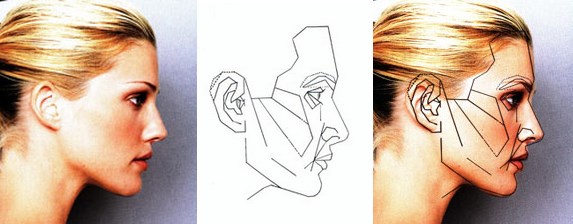
Image Courtesy: https://www.beautyanalysis.com/beauty-and-you/you-and-the-mask/repose-lateral-mask-application
Face Structure Analysis
In the below two faces, which among them do you think is beautiful? For both faces, the skin quality and expressions are the same. Then what makes the difference between these two faces?

To answer this question, we studied hundreds of faces and extracted statistical information on facial features. The aspects which make a big impact on facial attraction are provided in the below table. The attractive facial features are gender specific. For female, the features that make the most impact is Bitemporal-to-Bizygomatic Ratio, Eye canthal tilt, Bigonion-to-Bizygomatic Ratio, Lower Lip Height, Chin Length-to-Philtrum Length Ratio, Chin Angle, and Mouth Width to Nose Width Ratio. For a male face, it is Bitemporal To Bizygomatic Ratio, Mouth Width To Nose Width Ratio, Nose Width, and Upper Lip To Lower Lip Ratio. Refer below table for more detailed information.
Female Attractive Features
| Feature Name | Remarks | Effectiveness | Ideal PCI Value |
|---|---|---|---|
| Bitemporal To Bizygoma Ratio | Larger | 10 | 1.0415 |
| Eye Canthal Tilt Angle | Larger | 8.7 | 14.2114 |
| Chin Length To Philtrum Length Ratio | Smaller | 7.3 | 2.2876 |
| Eye Width To Height Ratio | Smaller | 7 | 2.6417 |
| Interpupillary Width To Bizygomatic Width Ratio | Larger | 6.7 | 0.4888 |
| Bigonion To Bizygoma Ratio | Smaller | 6.7 | 0.7022 |
| Mouth Width To Nose Width Ratio | Larger | 6.5 | 1.5034 |
| Chin Angle | Smaller | 6.4 | 128.7244 |
| Lip Lower Height | Larger | 6.3 | 33.2243 |
| Lip Upper Height | Larger | 5.5 | 35.895 |
| Nose Width | Smaller | 5.2 | 181.4405 |
| Eye Average Height | Larger | 4.7 | 60.8911 |
| Eyetobrow Inside Distance | Larger | 4.4 | 101.3852 |
| Chin Length | Smaller | 4.4 | 148.7754 |
| Bizygoma To Mid Face Height Ratio | Smaller | 4.2 | 1.7199 |
| Jaw Average Angle | Larger | 3.5 | 154.7037 |
| Subnasale Stomion To Stomion Chin Ratio | Larger | 3.5 | 0.4798 |
| Face Height Middle Third To Lower Third Ratio | Larger | 3.4 | 1.6106 |
| Brow Average Length | Larger | 2.8 | 202.9699 |
| Eye Average Length | Larger | 2.7 | 153.7138 |
| Mouth Length | Smaller | 2.7 | 270.7904 |
| Brow Average Thickness | Larger | 2.4 | 30.7468 |
| Brow External Distance | Larger | 2.4 | 575.1225 |
| Eye External Distance | Larger | 2.3 | 488.8263 |
| Upper Lip To Lower Lip Ratio | Smaller | 1.9 | 1.0769 |
| Bitemporal Width | Larger | 1.8 | 712.9662 |
| Brow Average Curve Angle | Smaller | 1.7 | 158.6125 |
| Eye Internal Distance | Larger | 1.7 | 184.3636 |
| Nose Length | Larger | 1.7 | 260.858 |
| Nose Angle | Larger | 1.5 | 148.2872 |
| Philtrum Length To Mouth Length Ratio | Larger | 1.5 | 0.2509 |
| Eyetobrow Outside Distance | Larger | 1.3 | 96.0725 |
| Mid Face Height | Larger | 1.2 | 400.7244 |
| Nose Length To Philtrum Length Ratio | Smaller | 1.2 | 4.013 |
| Brow Internal Distance | Larger | 0.9 | 172.5357 |
| Bigonial Width | Smaller | 0.8 | 478.9656 |
| Bizygoma Width | Larger | 0.3 | 684.2401 |
| Philtrum Length | Smaller | 0.2 | 67.0617 |
| Bizygoma To Face Height Ratio | Larger | 0.1 | 1.056 |
| Lateral Canthus To Alar Angle | Smaller | 0 | 50.2114 |
Male Attractive Features
| Feature Name | Remarks | Effectiveness | Ideal PCI Value |
|---|---|---|---|
| Bitemporal To Bizygoma Ratio | Larger | 10 | 1.0437 |
| Mouth Width To Nose Width Ratio | Larger | 8.1 | 1.402 |
| Nose Width | Smaller | 7 | 196.9517 |
| Interpupillary Width To Bizygomatic Width Ratio | Smaller | 5.9 | 0.4641 |
| Eye Canthal Tilt Angle | Larger | 5.5 | 7.6577 |
| Eyetobrow Outside Distance | Smaller | 5.4 | 81.8682 |
| Philtrum Length To Mouth Length Ratio | Larger | 5.1 | 0.3026 |
| Lip Upper Height | Smaller | 4.9 | 32.378 |
| Chin Angle | Smaller | 4.8 | 131.8199 |
| Chin Length To Philtrum Length Ratio | Smaller | 4.4 | 2.3718 |
| Mouth Length | Smaller | 3.8 | 275.2024 |
| Nose Length To Philtrum Length Ratio | Smaller | 3.7 | 3.3537 |
| Upper Lip To Lower Lip Ratio | Smaller | 3.7 | 1.1569 |
| Brow Average Thickness | Smaller | 3 | 34.8482 |
| Eye Internal Distance | Smaller | 3 | 182.6981 |
| Lip Lower Height | Smaller | 3 | 28.3403 |
| Lateral Canthus To Alar Angle | Larger | 2.8 | 50.8879 |
| Eye Width To Height Ratio | Smaller | 2.6 | 2.8973 |
| Eyetobrow Inside Distance | Smaller | 2.3 | 89.3334 |
| Nose Angle | Smaller | 2.1 | 148.6552 |
| Eye Average Height | Smaller | 2 | 52.0301 |
| Brow Internal Distance | Smaller | 1.9 | 168.8763 |
| Eye External Distance | Smaller | 1.9 | 477.0516 |
| Mid Face Height | Smaller | 1.5 | 410.0199 |
| Bizygoma To Face Height Ratio | Larger | 1.5 | 1.0282 |
| Subnasale Stomion To Stomion Chin Ratio | Smaller | 1.4 | 0.4588 |
| Bigonial Width | Smaller | 1.3 | 506.9601 |
| Eye Average Length | Smaller | 1.2 | 147.8659 |
| Bizygoma Width | Smaller | 1.1 | 704.5795 |
| Bigonion To Bizygoma Ratio | Smaller | 1 | 0.7213 |
| Philtrum Length | Larger | 0.8 | 82.5533 |
| Brow Average Curve Angle | Larger | 0.7 | 158.4599 |
| Brow External Distance | Smaller | 0.6 | 581.904 |
| Face Height Middle Third To Lower Third Ratio | Larger | 0.6 | 1.4866 |
| Bitemporal Width | Larger | 0.3 | 736.2539 |
| Nose Length | Smaller | 0.3 | 268.4474 |
| Jaw Average Angle | Smaller | 0.3 | 153.6105 |
| Bizygoma To Mid Face Height Ratio | Smaller | 0.3 | 1.7309 |
| Chin Length | Smaller | 0.2 | 191.4794 |
| Brow Average Length | Smaller | 0 | 207.8034 |
Unisex Attractive Features
| Feature Name | Remarks | Effectiveness | Ideal PCI Value |
|---|---|---|---|
| Eye Canthal Tilt Angle | Larger | 10 | 12.8839 |
| Bitemporal To Bizygoma Ratio | Larger | 9.5 | 1.0428 |
| Mouth Width To Nose Width Ratio | Larger | 8.9 | 1.4774 |
| Nose Width | Smaller | 7.7 | 181.0578 |
| Chin Angle | Smaller | 7 | 129.4383 |
| Eye Width To Height Ratio | Smaller | 6.8 | 2.6814 |
| Chin Length To Philtrum Length Ratio | Smaller | 6.7 | 2.307 |
| Chin Length | Smaller | 5.5 | 158.6112 |
| Bigonion To Bizygoma Ratio | Smaller | 5.5 | 0.7079 |
| Upper Lip To Lower Lip Ratio | Smaller | 4.4 | 1.092 |
| Face Height Middle Third To Lower Third Ratio | Larger | 4.4 | 1.5867 |
| Mouth Length | Smaller | 4.3 | 266.5676 |
| Bizygoma To Face Height Ratio | Larger | 3.1 | 1.0534 |
| Brow Average Thickness | Smaller | 2.8 | 31.0712 |
| Lip Lower Height | Larger | 2.4 | 31.1745 |
| Interpupillary Width To Bizygomatic Width Ratio | Larger | 2.4 | 0.4808 |
| Bizygoma To Mid Face Height Ratio | Smaller | 2.4 | 1.7285 |
| Bigonial Width | Smaller | 2.3 | 482.2323 |
| Philtrum Length | Smaller | 2.2 | 70.2458 |
| Eye Average Height | Larger | 2 | 57.0436 |
| Subnasale Stomion To Stomion Chin Ratio | Larger | 1.9 | 0.4731 |
| Eyetobrow Outside Distance | Smaller | 1.5 | 89.8257 |
| Jaw Average Angle | Larger | 1.5 | 154.187 |
| Eyetobrow Inside Distance | Larger | 1.4 | 95.9381 |
| Eye Internal Distance | Smaller | 1.4 | 180.9958 |
| Philtrum Length To Mouth Length Ratio | Larger | 1.4 | 0.268 |
| Bizygoma Width | Smaller | 1.3 | 683.222 |
| Mid Face Height | Smaller | 1.1 | 397.11 |
| Lateral Canthus To Alar Angle | Larger | 1.1 | 50.6137 |
| Brow Internal Distance | Smaller | 1 | 168.2486 |
| Nose Angle | Smaller | 0.9 | 147.9367 |
| Eye Average Length | Larger | 0.5 | 149.966 |
| Brow Average Length | Larger | 0.4 | 201.9581 |
| Eye External Distance | Smaller | 0.3 | 478.3444 |
| Nose Length | Smaller | 0.3 | 259.787 |
| Nose Length To Philtrum Length Ratio | Larger | 0.2 | 3.8286 |
| Bitemporal Width | Larger | 0.1 | 713.3418 |
| Brow Average Curve Angle | Smaller | 0.1 | 158.5797 |
| Brow External Distance | Smaller | 0 | 568.9826 |
| Lip Upper Height | Larger | 0 | 33.8387 |
The Effectiveness score is calculated based on the impact on attractiveness. This is scored separately for females and males because each feature has a different impact on each gender.
The unit used in this chart is PCI (Photographic Canthal Index).
To further evaluate the findings of this software, we are going to analyze a list of celebrities it created based on their beauty score, both males and females. We will be looking at possible reasons for listing them this way, taking into account symmetry, face shapes, skin quality, makeup, and/or other facial features.
The top 5 celebrity female faces with the highest beauty score

As we can see from the figure above, we can see that amongst the top 5 most beautiful female celebrities, the predominant shape is triangle.
The skin quality observed amongst the women is exceptionally smooth, with no apparent marks or distinctive characteristics.
The makeup is done in a way that complements their faces, the most common and being contouring and shading in the temple areas. This is suggested to reduce the width of the forehead for these particular shapes.
Furthermore, Shay Mitchell and Emma Watson have contour around their jawline to make it appear slimmer and reduce the sharpness. The main goal for the triangle shape is to make the face look longer and a little rounder, to balance out the proportions of the face.
On the other hand, the celebrities with the heart-shaped faces, such as Rosie Huntington Whiteley, Kate Upton, and Reese Witherspoon, have implemented slightly different techniques to enhance the overall appearance. For example, they have highlighted the jaw and chin areas with lighter foundation in order to create an illusion of more width.
Overall, their facial features and structure are symmetrical to the eye, with no extreme angles or sizes.
The top 5 celebrity male faces with the highest beauty score

Looking at figure above, we can see that amongst the top 5 most beautiful male celebrities, the best looking shapes according to AI are rectangle and heart.
The rectangle face shape is observed to be symmetrical due to the width of the forehead, cheekbones, and jawline being almost equal. In contrast, the heart shape presents prominent cheekbones, a wide forehead, and a narrow chin.
The go-to hairstyle for these particular celebrities is shorter sides and a longer top.
The overall facial build looks symmetrical to the eye with no distinctive irregularities.
Standout features that can be noted are a prominent jawline, wide forehead, and a short stubble or no beard at all.
The skin quality is smooth with no particular marks.
Face shape
The shape of the face is determined by the bone structure of the skull. Furthermore, research shows that the structure and shape stem from genetic variations [14].
Knowing and understanding the shape of the face has become an important piece of knowledge in the beauty world. Based on your shape, you can pick out the most flattering hairstyle, a pair of glasses, and what to accent when doing makeup.
Over the years, multiple variants of shapes have been suggested as the ones that could fit the whole population of our planet. Today, scientists have identified nine distinct shapes.
Although, according to various sources, the shapes and names show slight dissimilarities, the following general shapes can be outlined: round, square, oblong, heart, diamond, triangle, rectangle, pear, and oval.
If you are unsure which one applies to you in particular, you can figure out yours from the below Figure. There are also numerous apps and websites that can help you figure out your face shape.
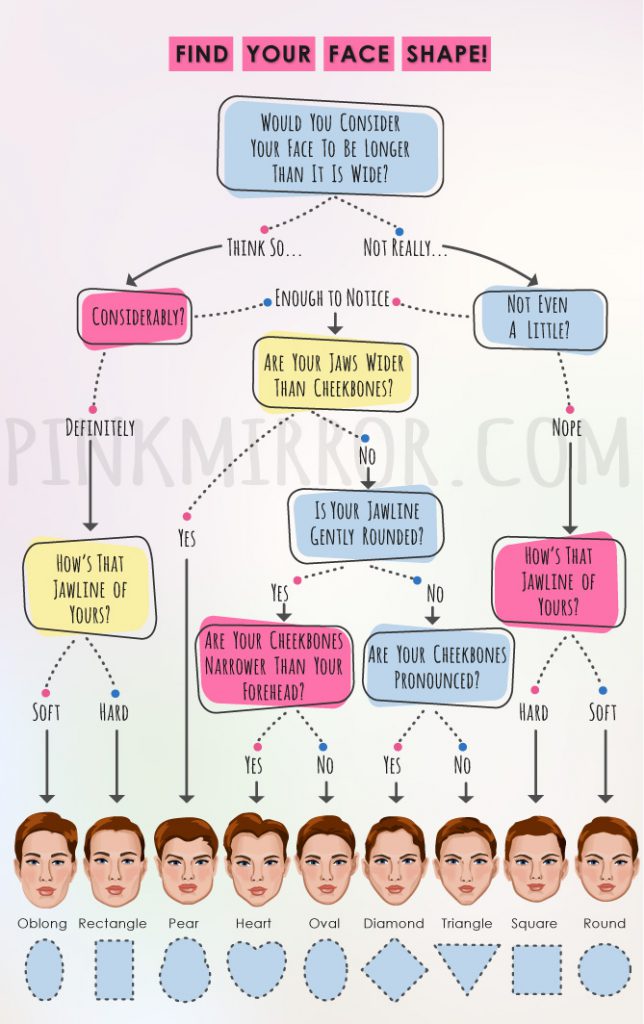
Female Face Shapes and perceptions
Based on the beauty score of female celebrities research, the most attractive face shape for women is a triangle. An oval face shape is widely considered attractive, while heart, round, diamond, rectangle, and square face shapes are also considered attractive to varying degrees. On the other hand, pear and oblong face shapes are not typically seen as attractive.
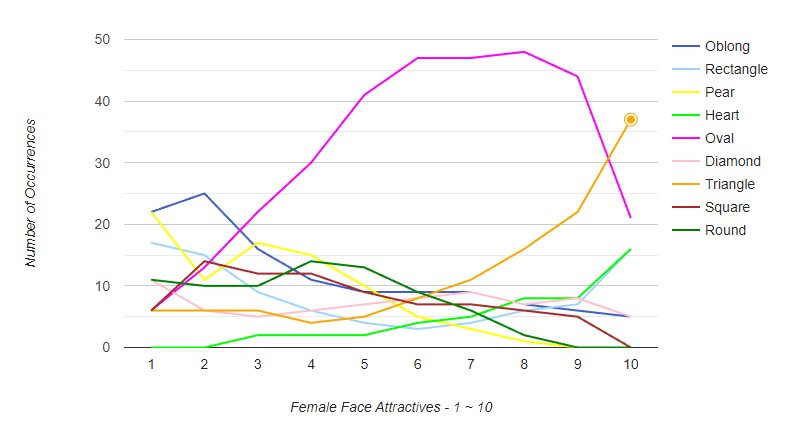
The target of the makeup/style should be as follows. Pear and Oblong face shapes need to look Oval shape to improve their attractiveness. Rest all face shapes needs to look like Triangle face shape.
Male Face Shapes and perceptions
Based on the beauty score of male celebrities, the most attractive face shapes for men are rectangle and heart. Oval, diamond, round, square, and triangle face shapes are generally considered to be attractive, while pear and oblong face shapes are not typically seen as attractive.
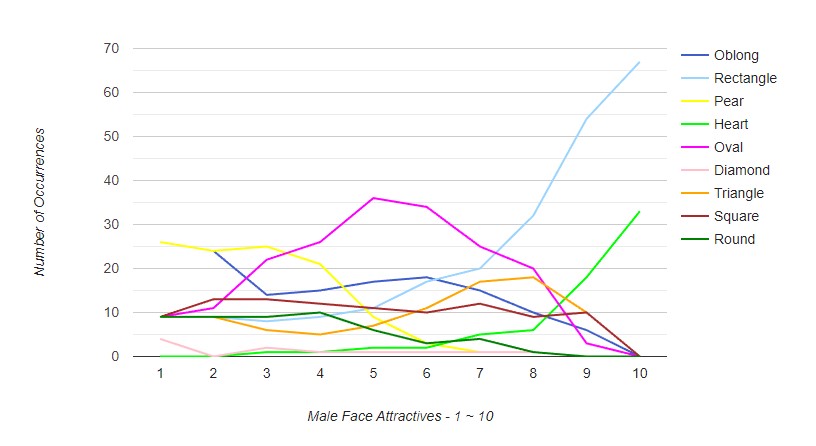
The target of the makeup/style should be as follows. Pear and Oblong face shapes need to look Oval shape to improve their attractiveness. Rest all face shapes needs to look like Rectangle face shape.
Find your face shape on Pinkmirror.com instantly with AI-powered tools.
Femininity vs Masculinity
Feminine and masculine facial features are generally perceived as being distinct and different from one another. Common characteristics that are often associated with feminine facial features include:
- Upturned Eyes
- An oval or triangle face shape
- Shorter Chin Length
- Thinner Eyebrows
- Longer Nose Length To Philtrum Length Ratio
- Full lips
- High cheekbones
- A smaller chin
- Large, round eyes
- Smooth, clear skin
- A smaller nose
- A narrow jawline
Some common characteristics that are often associated with masculine facial features include:
- Lower Eye Canthal Tilt
- A Rectangular face shape
- Longer Chin Length
- Thicker Eyebrows
- Shorter Nose Length To Philtrum Length Ratio
- A strong, prominent jawline
- A larger nose
- A larger brow bone
- A receding hairline
- A thicker neck
- Facial hair, such as a beard or mustache
What defines female features and male features?
| Feature Name | Effectiveness |
|---|---|
| Chin Length | 10 |
| Eye Canthal Tilt Angle | 9.8 |
| Brow Average Thickness | 9.3 |
| Mouth Width To Nose Width Ratio | 7.7 |
| Nose Length To Philtrum Length Ratio | 7.6 |
| Philtrum Length | 7.2 |
| Philtrum Length To Mouth Length Ratio | 6.3 |
| Face Height Middle Third To Lower Third Ratio | 5.8 |
| Upper Lip To Lower Lip Ratio | 5.4 |
| Nose Width | 5.3 |
| Bizygoma To Face Height Ratio | 5.3 |
| Bigonion To Bizygoma Ratio | 5.1 |
| Eye Width To Height Ratio | 5 |
| Chin Angle | 4.6 |
| Brow Average Length | 4.4 |
| Bigonial Width | 4.3 |
| Brow External Distance | 3.5 |
| Nose Length | 3.5 |
| Bitemporal Width | 3.3 |
| Lip Upper Height | 3.3 |
| Bizygoma Width | 3.2 |
| Eye Internal Distance | 3 |
| Eyetobrow Outside Distance | 2.9 |
| Mid Face Height | 2.9 |
| Brow Average Curve Angle | 2.7 |
| Mouth Length | 2.4 |
| Eye External Distance | 2.3 |
| Nose Angle | 1.9 |
| Interpupillary Width To Bizygomatic Width Ratio | 1.9 |
| Eye Average Length | 1.7 |
| Eye Average Height | 1.4 |
| Bitemporal To Bizygoma Ratio | 1.4 |
| Subnasale Stomion To Stomion Chin Ratio | 1.2 |
| Brow Internal Distance | 0.8 |
| Eyetobrow Inside Distance | 0.5 |
| Bizygoma To Mid Face Height Ratio | 0.3 |
| Chin Length To Philtrum Length Ratio | 0.3 |
| Lip Lower Height | 0.2 |
| Jaw Average Angle | 0.2 |
| Lateral Canthus To Alar Angle | 0 |
Outcome
Based on the overall outcome of the analysis and measuring criteria, we can outline a few feasible reasons for the AI beauty tool to list those celebrities in that particular order.
- The skin quality is good, with no visible marks or noticeable imperfections.
- The hair and makeup choices complement the face shape.
- All the shapes have distinguishable angles. For example, a noticeable jawline, prominent cheekbones, or a pointy chin. However, they do not stand out from the overall appearance.
Apart from this, the tool itself is entertaining to use, and it could potentially give a person some insight into what their facial features signal to the outside world. Additionally, it can give people an idea of how to balance out the overall features visually with the help of makeup, hairstyles, or glasses.
Conclusion
Beauty has been a subject of interest for centuries. With extensive amounts of research done over the years and outlined in this study, we have learned that there is no single constructing factor that can determine whether someone can be equally attractive to every single person. Furthermore, there is no doubt that there is a wide range of new-age software that can do a lot of groundwork for humans by reading faces and extracting information.
Disclamer
The precision of any analytical endeavor, including ours at PinkMirror, is deeply intertwined with the depth and breadth of statistical scrutiny applied. We rigorously examined hundreds of facial profiles, utilizing the expertise of respected professionals. Nevertheless, it’s important to understand that no analysis can claim absolute accuracy. So, while PinkMirror strives for excellence, we acknowledge the intrinsic margin of potential variance.
Reference list
1 Uniphiz.com. n.d. Face Reading History – Practice Of Physiognomy, Phrenology, Personality, Astrology. [http://www.uniphiz.com/physiognomy_history.htm].
2 Little, A., Jones, B. and DeBruine, L., 2011. Facial attractiveness: evolutionary based research. Philosophical Transactions of the Royal Society B: Biological Sciences, 366(1571), pp.1638-1659. [https://royalsocietypublishing.org/doi/10.1098/rstb.2010.0404]
3 R. Thornhill, S.W. Gangsted. Facial attractiveness. Trends in Cognitive Sciences, 3 (1999), pp. 452-460.
4 A.P. Møller, J.P. Swaddle. Asymmetry, developmental stability, and evolution. Oxford University Press, Oxford (1997). [https://books.google.es/books?id=XSgyfa2Sw9MC&lpg=PA1&ots=dwDo23KeW6&lr&pg=PR10#v=onepage&q&f=false]
5 Etcoff, N. Survival of the Prettiest: The Science of Beauty (Anchor/Doubleday, 1999).
6 Perrett, D. I. et al. Effects of sexual dimorphism on facial attractiveness. Nature 394, 884–887 (1998).
7 Rhodes, G. et al. Attractiveness of facial averageness and symmetry in non-Western cultures: in search of biologically based standards of beauty. Perception 30, 611–625 (2001).
8 Samuels, C. A. & Ewy, R. Aesthetic perception of faces during infancy. Br. J. Dev.Psychol. 3, 221–228 (1985).
9 Langlois, J. H. et al. Infant preferences for attractive faces: rudiments of a stereotype?Dev. Psychol. 23, 63–69 (1987).
10 Schaefer, K. et al. Female appearance: facial and bodily attractiveness as shape.Psychol Sci 48, 187–204 (2006).
11 Fink, B. et al. Second to fourth digit ratio and face shape. Proc R Soc B 272, 1995–2001, doi: 10.1098/rspb.2005.3179 (2005).
12 Schaefer, K., Fink, B., Mitteroecker, P., Neave, N. & Bookstein, F. L. Visualizing facialshape regression upon 2nd to 4th digit ratio and testosterone. Coll Antropol 29, 415–419(2005).
13 Shackelford, T.K.; Larsen, R.J. Facial asymmetry as an indicator of psychological,emotional, and physiological distress. J. Pers. Soc. Psychol. 1997, 72, 456–466.
14 PLOS. “Face shape is in the genes: Genome-wide association study identifies genetic variants that contribute to healthy facial traits.” ScienceDaily. ScienceDaily, 25 August 2016. [https://www.sciencedaily.com/releases/2016/08/160825151603.htm]
16 K. Grammer, B. Fink, A. Juette, G. Ronzal, R. Thornhill. Female faces and bodies: Ndimensionalfeature space and attractiveness. G. Rhodes, L.A. Zebrowitz (Eds.), Advancesin visual cognition, vol. 1: facial attractiveness, Ablex, Westport, CT (2002) [https://psycnet.apa.org/record/2001-05852-004]
17 Ward, D., 2013. The Familiarity Principle Of Attraction. [online] Psychology Today. Available at: <https://www.psychologytoday.com/us/blog/sense-and-sensitivity/201302/the-familiarity-principle-attraction>
18 Galton, F. (1878). Composite portraits. Journal of the Anthropological Institute of Great Britain & Ireland, 8, 132-144.
19 Valentine,T., Darling S., Donnelly M. Psychonomic Bulletin & Review 2004, 11 (3), 482-487.
20 J.H. Langlois, L.A. Roggman. Attractive faces are only average. Psychological Science, 1 (1990), pp. 115-121. [https://doi.org/10.1111/j.1467-9280.1990.tb00079.x]
21 Rhodes G., Zebrowitz L.A., Clark A., Kalick S.M., Hightower A., McKay R. Do facial averageness and symmetry signal health? Evol Hum Behav. 2001 Jan;22(1):31-46. [https://pubmed.ncbi.nlm.nih.gov/11182573/]
22 Fink, B., Grammer, K., & Thornhill, R. (2001). Human (Homo sapiens) facial attractiveness in relation to skin texture and color. Journal of Comparative Psychology, 115(1), 92–99. [https://doi.apa.org/doiLanding?doi=10.1037%2F0735-7036.115.1.92]
23 http://www.beautyanalysis.com/wp-content/uploads/2014/10/jco_2002-06-339.pdf
24 https://www.intmath.com/blog/mathematics/is-she-beautiful-the-new-golden-ratio-4149
